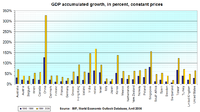
Photo from wikipedia
This article explored the dynamic nexus among economic growth, industrialization, medical technology, and healthcare expenditure in West Africa while using urbanization and aged population as control variables. West African countries… Click to show full abstract
This article explored the dynamic nexus among economic growth, industrialization, medical technology, and healthcare expenditure in West Africa while using urbanization and aged population as control variables. West African countries were sub-sectioned into low-income (LI) and lower-middle-income (LMI) countries. Panel data extracted from the World Development Indicators (WDI) from 2000 to 2019 were used for the study. More modern econometric techniques that are vigorous to cross-sectional dependence and slope heterogeneity were employed in the analytical process in order to provide accurate and trustworthy results. The homogeneity test and cross-sectional dependency test confirmed the studied panels to be heterogeneous and cross-sectionally dependent, respectively. Moreover, the CADF and CIPS unit root tests showed that the variables were not integrated in the same order. This, thus, leads to the employment of the PMG-ARDL estimation approach, which unveiled economic growth and urbanization as trivial determinants of healthcare expenditure in the LI and LMI panels. However, the results affirmed industrialization as a major determinant of healthcare expenditure in the LI and LMI panels. Additionally, medical technology was confirmed to decrease healthcare expenditure in the LMI panel, whereas in the LI panel, an insignificant impact was witnessed. Also, the aged population was found to intensify healthcare expenditure in both the LI and LMI panels. Lastly, on the causal connection between the series, the outcome revealed a mixture of causal paths among the variables in all the panels. Policy recommendations have therefore been proposed based on the study's findings.
Journal Title: Frontiers in Public Health
Year Published: 2022
Link to full text (if available)
Share on Social Media: Sign Up to like & get
recommendations!